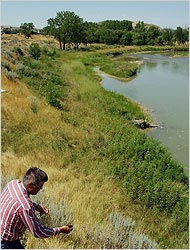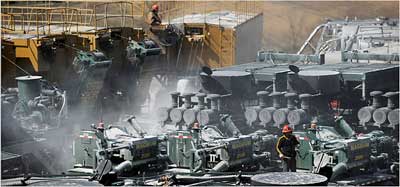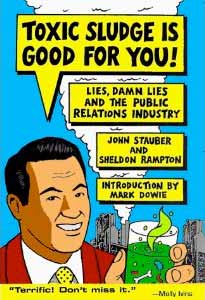Press
HUGHESVILLE, Pa. — At first, Raymond Gregoire did not want to listen to the raspy voice on his answering machine offering him money for rights to drill on his land. They want to ruin my land, he thought. But he called back anyway a week later to hear more.
By the end of February, he had a contract in hand for $62,000, and he pulled together a group of 75 neighbors who signed $3 million in deals.
“It’s a modern-day gold rush in our own backyard,” Mr. Gregoire said.
Kalim A. Bhatti for The New York Times.Property owners at a seminar in Clarks Summit, Pa., on negotiating with gas lease companies.
Jeff Swensen for The New York Times.Fracture drilling workers run machinery on a farm outside of Pittsburgh. Companies are risking big money on rural Pennsylvania, producing billions of dollars' worth of natural gas.
A chewy candy bar with the ironic name Toxic Waste Nuclear Sludge has been recalled due to concerns that the bars contain elevated levels of lead. Here is the press release from the U.S. Food and Drug Administration. No this is not a Yes Men art work.
Candy Dynamics, distributors of Toxic Waste® Nuclear Sludge® chew bars, has issued a recall of all lots, sizes and flavors of Nuclear Sludge® due to levels of lead that exceed the FDA standard. In addition, the company is discontinuing Nuclear Sludge®. Click here for more information.
Maureen Reilly of the Canadian listserv Sludge Watch commented:
The Toxic Waste candy that was recalled had only 0.24 ppm lead.
The EPA allows 400 ppm lead in children's play soil.
And the EPA even allowed sewage sludge compost containing 237 ppm lead (that's 1000 times more than the level in the candy) to be spread on childrens bare soil yards for poor black families in Baltimore.
The candy producer had the decency to call the candy Toxic Waste....unlike the sludge industry which calls its stuff that is 1000 times more contaminated: Beneficial Use Biosolids Organic Compost. (see Sourcewatch article).
The EPA should order a recall of this very real toxic sludge ...
Maureen Reilly (commenting on Howard Portnoy. "Alert: “Toxic Waste” candy recalled due to fears of lead contamination." Examiner.com. Jan. 17, 2011.
See: Organic Consumers Association. "Toxic sludge is good for you?". 2010.
See: Stauber, John, and Sheldon Rampton. Toxic Sludge is Good For You: Lies, Damn Lies and the Public Relations Industry. Common Courage Press, 2002. Print.
See: Patrick Trahey. "Sewage Sludge Everlasting." In These Times. April 19, 2010.
Editing by Daniel Trotta and Mohammad Zargham.
"U.S. government scientists have for the first time found chemical contaminants in drinking water wells near natural gas drilling operations, fueling concern that a gas-extraction technique is endangering the health of people who live close to drilling rigs."
Several million gallons of "frack" fluid for each well return to the surface as a heavy brine, far saltier than seawater. Disposal of these new volumes of brine is a challenge.
So far, well operators or their agents have been hauling most of the frack flowback to Ohio for underground injection, according to Peterson, because salt removal is expensive and only two Class II, or brine disposal, wells were permitted by West Virginia's Underground Injection Control program.
Now, though, nine commercial brine disposal injection wells are permitted, and seven are operating. Several more are in the permitting pipeline.
The DEP has not in the past required well operators to report their water management in detail.
See: Desalination of Oil Field Brine
See: Gas wells' leftovers may wash into Ohio | Columbus Dispatch Politics
"Of the 84,000 chemicals in commercial use in the United States -- from flame retardants in furniture to household cleaners -- nearly 20 percent are secret, according to the Environmental Protection Agency, their names and physical properties guarded from consumers and virtually all public officials under a little-known federal provision."
The quality of drinking water is an urgent concern for over forty million people who live in proximity to the Marcellus Shale.
"The 35-year-old federal law regulating tap water is so out of date that the water Americans drink can pose what scientists say are serious health risks — and still be legal.
Only 91 contaminants are regulated by the Safe Drinking Water Act, yet more than 60,000 chemicals are used within the United States, according to Environmental Protection Agency estimates. Government and independent scientists have scrutinized thousands of those chemicals in recent decades, and identified hundreds associated with a risk of cancer and other diseases at small concentrations in drinking water, according to an analysis of government records by The New York Times.
But not one chemical has been added to the list of those regulated by the Safe Drinking Water Act since 2000.
Other recent studies have found that even some chemicals regulated by that law pose risks at much smaller concentrations than previously known. However, many of the act’s standards for those chemicals have not been updated since the 1980s, and some remain essentially unchanged since the law was passed in 1974."
February 02, 2010. Cleveland Plain Dealer.
A drilling technique that is beginning to unlock staggering quantities of natural gas underneath Appalachia also yields a troubling byproduct: powerfully briny wastewater that can kill fish and give tap water a foul taste and odor.
With fortunes, water quality and cheap energy hanging in the balance, exploration companies, scientists and entrepreneurs are scrambling for an economical way to recycle the wastewater.
The Miller family buys bottled water for Jay, who has allergic reactions to sulfates, when the level of that pollutant rises in their tap water. Last year, Miller mysteriously developed hives that itched and bothered him for two weeks. Then his mother read about spiking levels of pollution in the nearby Monongahela River, the source of their tap water.
See: Urbina, Ian. “Regulation Is Lax for Water From Gas Wells.” The New York Times 26 Feb. 2011. Web. 27 Feb. 2011.
See: With Natural Gas Drilling Boom, Pennsylvania Faces an Onslaught of Wastewater
See: Do the natural gas industry’s surface water withdrawals pose a health risk?
The estimated population of Pulteney is about 1,300.
At times Sunday it looked like every one of them was crowded into the Pulteney Fire Hall to discuss the proposed plan to deposit contaminated wastewater in a former natural gas well.
More than 300 people came to hear a panel discuss the plan. Chesapeake Energy approached Pulteney officials last fall about the plan to dump the wastewater, which is generated from the hydrofracking process, into a well about a mile west of Keuka Lake.
Jim Robbins. September 10, 2006. New York Times.
It is a strange fight, Montana ranchers say. Raising cattle here in the parched American outback of eastern Montana and Wyoming has always been a battle to find enough water.
Now there is more than enough water, but the wrong kind, they say, and they are fighting to keep it out of the river.
Mark Fix is a family rancher whose cattle operation depends on water from the Tongue River. Mr. Fix diverts about 2,000 gallons per minute of clear water in the summer to transform a dry river bottom into several emerald green fields of alfalfa, an oasis on dry rangeland. Three crops of hay each year enable him to cut it, bale it and feed it to his cattle during the long winter.
“Water means a guaranteed hay crop,” Mr. Fix said.
But the search for a type of natural gas called coal bed methane has come to this part of the world in a big way. The gas is found in subterranean coal, and companies are pumping water out of the coal and stripping the gas mixed with it. Once the gas is out, the huge volumes of water become waste in a region that gets less than 12 inches of rain a year.

Mark Fix, a cattle rancher in eastern Montana, diverts about 2,000 gallons per minute of Tongue River water in the summer to grow hay for his livestock. But increased sodium in the water could endanger his hayfields.
See: Molly Ivins. (2004) C-Span Book TV Oct. 2, 2004. Bushwacked: Life in George W. Bush's America. Chapter: "Dick, Dubya, and Wyoming Methane." (152)
A federal judge has overturned water quality rules that were meant to protect southeastern Montana cropland from natural gas drilling but were assailed by Wyoming as a threat to energy production.
The rules covered the Tongue and Powder rivers, which flow north from the rich gas fields of northeastern Wyoming into primarily agricultural land in Montana.
Drafted by Montana and approved by the Environmental Protection Agency, the rules limited how much salty water - a byproduct of drilling - could enter the rivers. State officials said the EPA had not yet begun to enforce the rules, in part because of a pending lawsuit.
In a judgment in that case issued Tuesday, U.S. District Judge Clarence Brimmer in Cheyenne, Wyo., annulled the rules and sent them back to the EPA to reconsider. Brimmer wrote that the EPA had failed to give the water quality standards a full review when it approved them in 2003 and 2008.
The lawsuit has pitted natural gas companies backed by the state of Wyoming against the EPA and Montana.
The case represents one of several running skirmishes between Montana and Wyoming over the rivers that flow north across their shared border.
















